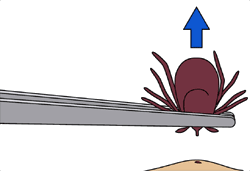Introduction
There are many tick-borne diseases found all over the world, including Lyme disease, Rocky Mountain Spotted Fever, Relapsing Fever, Tick-borne Encephalitis, Ehrlichiosis, Babesiosis, Tick Typhus and Tularaemia. Tick-borne diseases have an incubation period that varies from three to thirty days. Clinical signs may start with a rash at the site of the tick bite, and often involve headache, fever and other flu-like symptoms.
Are travellers and/or expat workers at risk?
Yes. Ticks are extremely effective at transmitting disease, so any tick bite has the potential to spread one of the tick-borne illnesses. Ticks are most likely in woods and pastures with grazing livestock or a population of wild herbivores.
How are tick-borne diseases prevented?
Preventing tick bites is the most effective way to prevent disease. You should:
-
Avoid areas likely to have lots of ticks - particularly wooded and bushy areas, high grass, leaf litter and areas with lots of grazing livestock or wild animals
-
Use insect repellents
-
20-30% DEET on skin; permethrin on clothing
-
-
Wear appropriate clothing
-
Wear long trousers, long sleeves, and long socks; light-coloured clothing enables ticks to be seen more easily
-
-
Tuck trouser legs into socks or boots or tape trousers to socks to keep ticks outside clothing
-
Remove ticks from your clothes before going indoors
-
Wash clothes with hot water and dry using high heat for at least one hour to kill any ticks still on clothing
-
Check for ticks at the end of each day, and remove any you find
A vaccine is available to protect against Tick-borne Encephalitis, that may be recommended for people camping and walking in infected areas of Europe and Asia in the spring or summer months. Treatment is available for many other tick-borne illnesses, but diagnosis can sometimes be difficult.
I got bitten by a tick - will I definitely get ill?
If the tick is attached for less than 24 hours disease transmission is very unlikely - but still possible. You should monitor your health carefully for any unusual signs or symptoms. If a rash develops around the bite site, you should promptly seek medical assistance and tell the doctor about the tick bite. However, sometimes people do not develop (or notice) the characteristic rash, despite having a tick-borne illness. For this reason, you should suspect tick-borne illness if you become ill with flu-like symptoms after having been in a tick area, whether or not you develop a rash.
Disease Information Sheets
Tick-borne diseases

back to topic list


How should ticks be removed?
The risk of transmission of disease is removed if the tick is removed promptly after attachment. The tick should be removed carefully and gently to avoid damaging it. Distressing or crushing the tick during removal may prompt it to regurgitate intestinal contents and saliva into the wound, increasing the likelihood of transmission of the microbes they are carrying that cause disease to humans. The US Centers for Disease Control and Prevention recommend the following steps to find and remove ticks:
-
Check yourself for ticks daily if you've been in a tick area
-
Inspect all parts of your body carefully including your armpits, scalp, and groin
-
Remove ticks that you find by grasping the tick firmly very close to the skin with a pair of blunt forceps or tweezers and pulling gently upwards until the tick’s jaws relax and release their grip - this may take a couple of minutes
-
Avoid crushing the tick's body
-
After removing the tick wash the skin with soap and water


